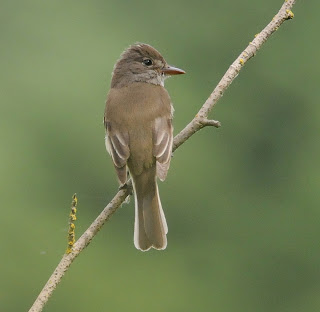
Click on picture(s) for a larger view.
Solution by Tony Leukering
Ooh, nasty! A green flycatcher thing! As you can probably imagine, I expected a diversity of species presented as answers for this quiz. I was right, but I guessed the wrong diversity of species! As is often the case on really tricky quizzes, only a plurality of respondents scored the correct species among the nine species submitted as answers, with no more than two respondents going for any particular incorrect species.
The quiz bird seems to not be tiny (relative to the small branch), but is certainly not a great, big thing. The upperparts coloration is olive-brown with a touch of gray. The bird seems to have bits of a thin eye ring and a bill that is longish and relatively thick-based. The mandible appears somewhat orangish with a vaguely and barely darker tip. The chin and throat appear whitish. The wingtip extends beyond the tip of the longest tertial (a feature called primary projection) about a half or so of the distance that the three tertials are visible. Additionally, the tip of the longest primary barely extends lower than the tips of the upper tail coverts. The tail is certainly not short, perhaps being a bit longish. There is little in the way of wing bars visible, but posture might be hiding such. Finally, the green background and the worn condition of the tertials and primaries both suggest a spring or summer photo date, if the picture was taken in the ABA Area.
The above should take us to the wonderful genus, Empidonax and, within that genus, to the difficult duo of Alder and Willow flycatchers. We can rule out the various members of Myiarchus and Contopus by primary projection; that of the crested flycatchers is generally shorter(about 25-40% the visible-tertials length) and that of pewees is much longer (100% or more the visible-tertials length). Tail length and breadth also provides some clues, as Myiarchus generally sport tails that are much longer relative to their basal width than our quiz bird and Olive-sided Flycatcher has quite a short tail for its size (in fact, that is a good separator from the wood-pewees). Finally, contrastingly pale eye rings, no matter their thickness and completeness, help to rule those other genera out.
Once we have arrived in Empidonax, eye ring rules out all species but the two already mentioned. I was expecting more answers from this genus and was prepared to discuss the various eye rings, but Gray has a large and obvious whitish eye ring, being particularly distinct behind the eye, where the ring extends into a point in what is called a tear-drop shape. If one gets oneself correctly into this genus when attempting an ID, eye rings this insignificant should immediately point one to the Traill's Flycatcher complex (Alder/Willow). At that point, those wishing to opt out of attempting more-specific ID are well within their rights, as these two are quite difficult. However, as this individual is certainly identifiable, we'll continue.
Alder Flycatcher tends to exhibit eye rings that are quite thin, but complete, or very nearly so, while Willow Flycatcher usually sports obviously broken eye rings, with the bits in front being particularly commonly missing. Our quiz bird, has a nearly complete eye ring that is broken vaguely in front and more distinctly behind and below. I'd call that character a wash, though, perhaps, leaning toward Willow. Alder tends to have longer primary projection than does Willow, being a considerably longer-distance migrant. However, there are multiple subspecies of Willow, and their primary projection varies with subspecies, with eastern birds having longer projection than do western birds. To my eye, this bird's primary projection looks to be in the eastern/western Willow overlap zone or on the small end for Alder. Again, the character seems to be a wash.
Willow has a generally longer, thicker-based bill than does Alder, but, again, there is significant overlap there. However, I would call this bird's bill one of the more definite features, being both quite long and fairly thick, so I'll give this one to Willow. I have found another head feature to be useful in separating the two, and that is the shape of the head between the peak of the crown and the base of the bill. Willows tend to have a very flat and sloped forehead that basically draws a straight line from peak of crown to base of bill. Alder, I find, tends to show a rounded protrusion about halfway from crown peak to bill base. Because this feature depends upon the precise way in which the individual bird holds its feathers, it can be tricky and/or ephemeral, and it takes watching a particular bird for a while to see what is what might be called the "true" shape. Our quiz bird has the barest of outdentations (great word, eh?) of the forehead, so I don't know how to score it, but I'd lean toward Willow.
Finally, Alder Flycatchers and eastern Willow Flycatchers show very black wings in fresh plumage, fading to off-black in worn plumage (in fact, this is a general difference between eastern Empidonax and western Empidonax). Our quiz bird's wings are not at all blackish, being more toward the brown end of things than even worn Alders or eastern Willows.
Steve Mlodinow took this picture of an adult Willow Flycatcher 10 July 2010 at Spencer Island, Snohomish Co., Washington.
Incorrect species provided as answers:
Olive-sided Flycatcher - 1
Eastern Wood-Pewee - 2
Gray Flycatcher - 2
Western Wood-Pewee - 1
Greater Pewee - 1
La Sagra's Flycatcher - 2
Dusky-capped Flycatcher - 1
Black Phoebe - 1
Congratulations to the 11 of 22 getting the quiz correct:
Ben Coulter
Pam Myers
Margie Joy
George Cresswell
Patty McKelvey
Sean Walters
Joe Bens
Marcel Such
Joel Such
Bryan Guarente
Robert McNab
Answer: Willow Flycatcher